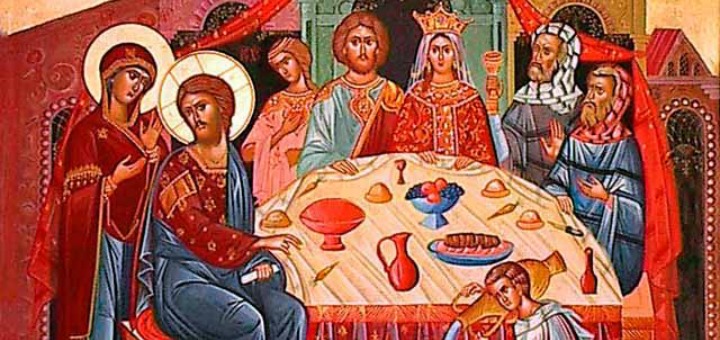This is a part two in a three-part series on the Byzantine wedding liturgies of betrothal and crowning. Specifically, we are discussing how these liturgies offer a unique illumination of three important principles of a good marriage: God’s faithfulness to his people, the importance of community, and the call to martyrdom.
In part one, we discussed the portrayal of God’s faithfulness in the Byzantine wedding liturgies and the importance of that faithfulness in making marriage sacramental and not merely a human contract. Today, we discuss how these liturgies emphasize the role of the community in marriage.
The Byzantine marriage liturgies are much longer than the average Western wedding rite, including the Roman Catholic rite. Much of the extra “stuff” consists of prayers to and remembrances of the saints in Heaven. There are at least thirty-seven separate references to saints or groups of saints (i.e. Isaac and Rebecca, the holy martyrs, etc.) in the betrothal and crowning liturgies combined. Keep in mind that this is only in the wedding liturgies and does not include the numerous references in the Divine Liturgy that generally follows.
In addition to calling upon the saints in Heaven, the Byzantine marriage liturgies pray specifically for those present at the wedding. Of course, there are multiple prayers for the bride and groom, but there are also prayers for the congregation. The following is a small sample of these prayers (as given in Appendix V of John Meyendorff's Marriage An Orthodox Perspective, which contains the full text for the marriage liturgies):
“For this holy house and for all who enter with faith, reverence, and the fear of God, let us pray to the Lord” (118).
“That He will grant to them [the bride and groom] and to us all our petitions which are unto salvation” (119).
“Remember them [the bride and groom], O Lord our God, and the parents who have nurtured them, for the prayers of parents make firm the foundations of houses. Remember, O Lord our God, Thy servants the groomsman and the bridesmaid of the bridal pair, who have come together in this joy” (122).
This serves to give a very explicit emphasis on the role of the community in salvation and particularly in marriage. While a sense of community is certainly present in the Roman marriage rite and in other Western Christian marriage rites, its role is much more implicit. (And this is okay and even good. If we were focused on exactly the same things, there would be no point to having multiple churches within Catholicism).
The explicit focus on community in the Byzantine wedding is a catechetical experience of the importance of community--including our community in Heaven--in cultivating Christian families. It is a catechesis not only for the bride and groom but for all of the wedding’s attendants.
For the bride and groom, the wedding serves as a profound opportunity to hear about and pray to those saints who have actually lived marriage, even to their deaths. The liturgies provide more than just theoretical principles for the couple by also giving them living examples as guides and supports. Moreover, the bride and groom are reminded, in the prayers for their sponsors and for all those present, that the success of their marriage depends significantly on those around them.
For all others present, the wedding is a continued remembrance and experience of the role of the communion of saints in our lives. In addition, the prayers that are prayed explicitly for the couple’s community offer supernatural Grace as well as a natural reminder of the community’s importance. Surely the community must have some significance if we are going to pray for them multiple times in the liturgy.
Going forward from such a wedding, the married couple has a great responsibility to cultivate a supportive community around them--both on Earth and in Heaven--and the congregation likewise has a responsibility to support the couple both practically and prayerfully.
The Byzantine wedding’s emphasis on community is vital in modern times. Not only are we an individualized society, but even in Catholic circles, my experience has been that younger married couples receive some of the least amount of ministerial focus of any demographic. Marriage preparation ceases (although it probably shouldn’t) on the wedding day and young adult groups typically cater to the single crowd. Married people are also typically less available than single people, and so building community with them requires much more intentionality.
But in a world where the typical Catholic outcry is the breakdown of the family, the extra effort necessary to minister to married couples, who are the foundation of each family, is undeniably worth undertaking. Their road to martyrdom, which we will discuss in part three, requires the support of a community to be journeyed successfully.
A note about my source: I have referenced Father John Meyendorff’s book Marriage: An Orthodox Perspective. This book is an excellent resource for Eastern Catholics wanting to learn about the marriage liturgies, and in general, everything Father Meyendorff explains about the liturgies is in line with Eastern Catholic teaching. However, he takes an Orthodox perspective on marriage theology and canon law, which is one of the very few areas where Eastern Catholics and Eastern Orthodox Christians differ substantially. A Catholic reading this book should understand that, while it is an excellent source for understanding Orthodox teaching on marriage, it is not 100% congruous with Eastern Catholic teaching in theology and canon law.
Copyright 2015, Brittany Balke
Image: "Icon of the Wedding Feast of Cana at Galilee" Igor Stoyanov [Public Domain], via Wikimedia Commons
Works Cited
Meyendorff, John. Marriage: An Orthodox Perspective. Crestwood, N.Y.: St. Vladimir’s Seminary Press, 1975. Print.
About the Author

Guest
We welcome guest contributors who graciously volunteer their writing for our readers. Please support our guest writers by visiting their sites, purchasing their work, and leaving comments to thank them for sharing their gifts here on CatholicMom.com. To inquire about serving as a guest contributor, contact editor@CatholicMom.com.



.png?width=1806&height=731&name=CatholicMom_hcfm_logo1_pos_871c_2728c%20(002).png)
Comments